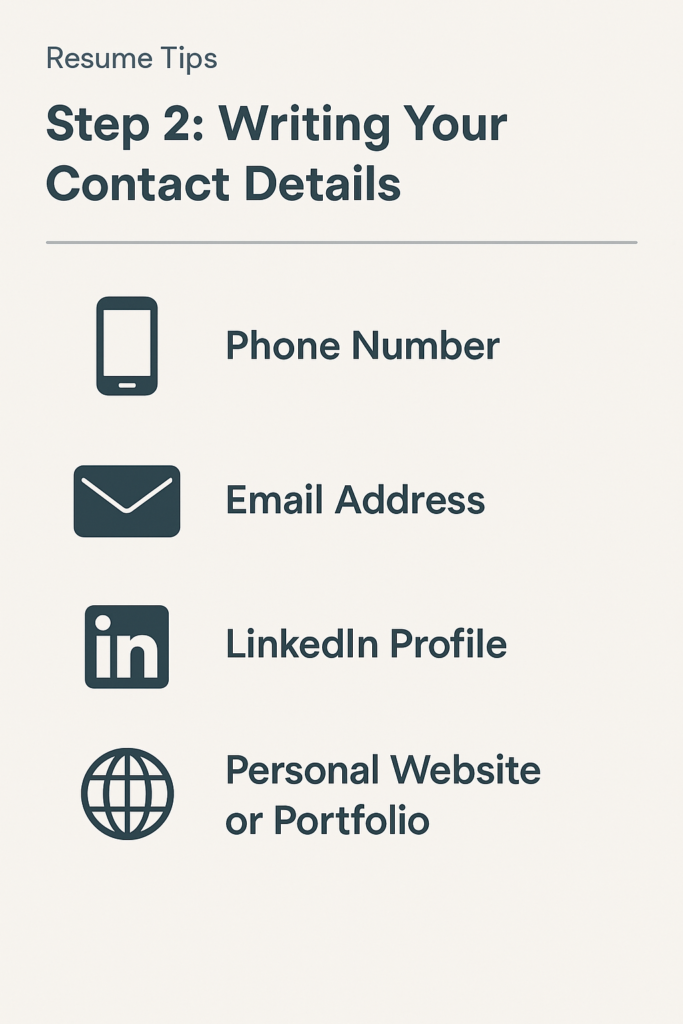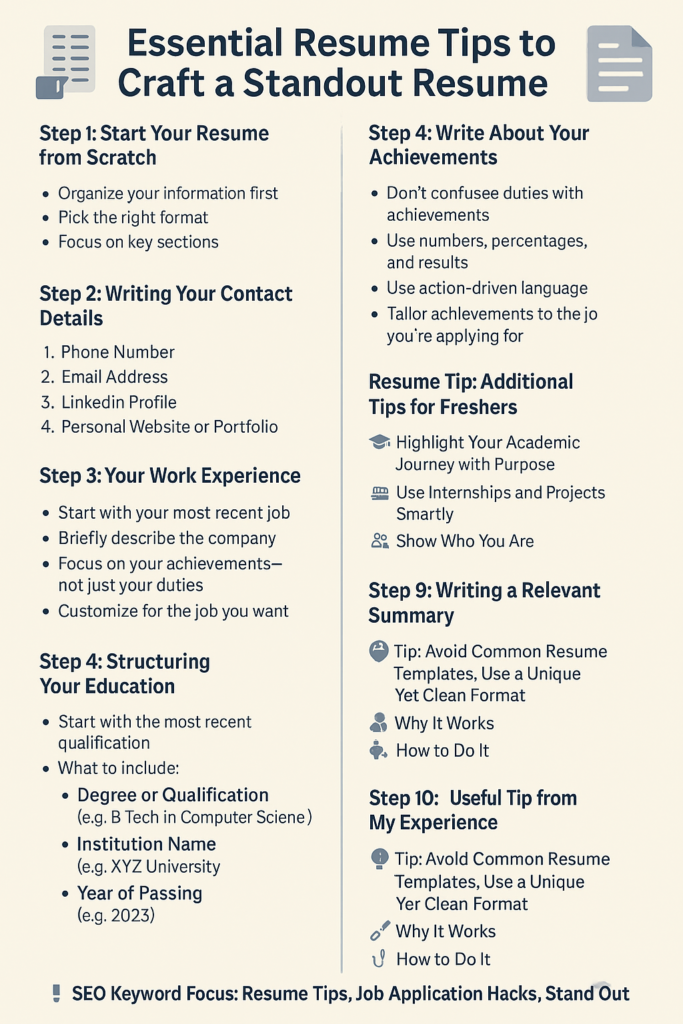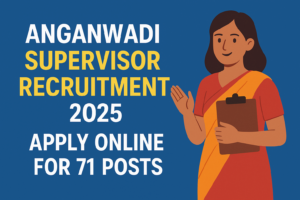Discover essential resume tips to craft a standout resume that grabs employers’ attention. From structuring your contact details to writing an impactful summary, learn how to highlight achievements, tailor your resume for specific jobs, and avoid common mistakes. Perfect for freshers and experienced candidates alike, this guide helps you build a professional resume that makes a strong first impression.
Table of Contents
Welcome to Hiring Alert Now! Whether you’re entering the job market for the first time or seeking your next big opportunity, creating an impressive resume is key to landing your dream job or internship. A well-crafted resume is not just a document; it’s your first chance to make a lasting impression. It serves as a personal marketing tool that showcases your skills, experiences, and unique strengths to potential employers.
In today’s competitive job market, simply listing your qualifications isn’t enough. You need to know how to highlight the right information in a way that grabs attention. That’s why we’ve put together this detailed guide, filled with essential resume tips, to help you stand out. From structuring your contact details to writing an impactful summary and showcasing your achievements, every section of your resume is crucial.
In this blog, we’ll walk you through the process of building a professional resume from scratch, focusing on what employers truly care about. If you’re a fresher, we’ll provide additional tips to ensure your resume shines even without extensive experience. By the end of this guide, you’ll have the tools to create a resume that not only reflects your qualifications but also demonstrates why you’re the perfect fit for the role you’re applying for. Let’s get started on crafting a resume that works for you!
Step 1: Start Your Resume from Scratch
Starting your resume from scratch can seem like a daunting task, but it’s actually the best way to ensure you create a tailored and impactful resume. Rather than relying on generic templates, starting fresh gives you the opportunity to craft a document that perfectly represents your skills, experience, and career goals.
Organize your information first: Before diving into design or formatting, gather all the key information you need to include. This will help you structure your resume logically and ensure that nothing important is left out. Start with your contact details, work experience, education, and achievements—these are the main sections that will form the foundation of your resume.
Pick the right format: The layout and design of your resume play a crucial role in making a great first impression. Use a clean, easy-to-read format with clearly defined sections and bullet points. Avoid clutter and keep the design simple. You want the employer to easily navigate your qualifications without getting lost in excessive details or distractions.
Focus on key sections: The most important sections of your resume are your professional summary, skills, work experience, and education. Begin by crafting a brief, compelling professional summary that highlights your key strengths and what you bring to the table. This will set the tone for the rest of the resume and capture the reader’s attention right from the start.
Starting from scratch also gives you the flexibility to tailor your resume for each job application. Each time you apply, you can tweak the content to emphasize the skills and experiences most relevant to the job you’re targeting.
By the end of this step, you’ll have a strong foundation to build upon and a clear direction for structuring the rest of your resume. The result will be a polished, professional resume that showcases your strengths and makes you stand out from other candidates.

Step 2: Writing Your Contact Details
When writing your resume, one of the first sections you need to focus on is your contact details. This section is crucial because it’s how potential employers will get in touch with you. So, it’s important to make sure your contact information is clear, accurate, and professional. Here’s how you can do it:
1. Phone Number
The most important piece of contact information is your phone number. Make sure you include a phone number that you check regularly, preferably your mobile number. Avoid using old or rarely checked numbers, as you don’t want to miss any calls from potential employers. Also, ensure that your voicemail message is professional and doesn’t include anything personal or inappropriate.
2. Email Address
Your email address is equally important. It’s often the primary way employers will communicate with you. Make sure your email address looks professional—ideally, it should just be your first and last name. Avoid using nicknames, old email addresses, or anything that could look unprofessional. For example, instead of “crazyguy1234@gmail.com,” use something like “john.doe@gmail.com.”
3. LinkedIn Profile
Including a link to your LinkedIn profile is an excellent idea, especially if it’s well-crafted and up to date. Many employers will look at your LinkedIn profile for additional information beyond your resume. It helps give them a better sense of your professional background, skills, and connections. If you don’t have a LinkedIn profile yet, now is the time to create one.
4. Personal Website or Portfolio
If you have a personal website or an online portfolio showcasing your work, be sure to include the link. This is especially relevant for creative roles like design, writing, or development. Having an online portfolio allows you to present your work in a way that goes beyond the limitations of a traditional resume.
By providing these key details, you make it easy for employers to reach out to you. Just remember to keep the contact information simple and professional, and double-check that everything is accurate. This step may seem small, but it’s the first impression you’ll make, so it’s important to get it right!

Step 3: Your Work Experience
When it comes to crafting a strong resume, the “Work Experience” section is where you get to show what you’ve actually done—not just what you know. For both jobs and internships, this section is one of the first things recruiters look at. So, it’s important to present your experience in a way that highlights your contributions and shows real impact. Here’s how to do it effectively.
Start with your most recent job
Always list your current or most recent job first, then go backward. This format is called reverse chronological order and it helps employers see your career progression clearly. For each role, include the company name, your job title, and the time period you worked there (month and year is enough).
Briefly describe the company
If your current or previous employers aren’t well-known, it’s a smart move to add a one-liner about the company. For example, if you worked at a funded startup, mention that it raised capital or was founded by alumni from top institutes. This helps recruiters understand the scale and credibility of the company, especially when they’re unfamiliar with it.
Focus on your achievements—not just your duties
This is where many people make a mistake. Don’t just write a list of your day-to-day tasks. Instead, talk about what you achieved. Use action words like “led,” “designed,” “improved,” or “increased.” If possible, support your statements with data. For instance:
“Improved customer onboarding process, reducing sign-up time by 30%.”
Customize for the job you want
Tailor your descriptions based on the role you’re applying for. Highlight responsibilities and achievements that align with the new job’s requirements. This shows the recruiter that you understand what they’re looking for.
Remember, this section isn’t just about filling space—it’s about telling your story. Your experience is what sets you apart, so don’t be afraid to showcase it with confidence.
Step 4: Write About Your Achievements
When you’re listing your past experiences, don’t just stop at describing your job responsibilities—talk about your achievements. This is where your resume truly starts to stand out. Anyone can list what their role was, but what you accomplished in that role is what gets the recruiter’s attention. This step is often skipped, but it’s one of the most powerful resume tips you’ll come across.
Don’t confuse duties with achievements
Let’s be honest: saying “Managed social media accounts” doesn’t tell much. But if you say “Increased Instagram engagement by 60% in 3 months through strategic content planning,” now you’re showing real value. Achievements are measurable, impactful, and give recruiters a clear idea of what you bring to the table.
Use numbers, percentages, and results
Wherever possible, use data to back your claims. Numbers speak louder than words. Whether it’s increasing sales, reducing costs, growing a social media following, or improving processes, quantifying your success adds credibility.
For example:
- ✅ “Generated 120+ leads monthly through optimized Google Ads campaigns.”
- ✅ “Reduced customer complaint resolution time by 40% with a streamlined support workflow.”
Use action-driven language
Start each achievement with a strong action verb—like “spearheaded,” “designed,” “led,” “developed,” or “increased.” These words create a dynamic tone and keep your resume engaging and focused.
Tailor achievements to the job you’re applying for
Make your resume relevant. If you’re applying for a marketing role, highlight campaigns you ran or growth you drove. If it’s a tech job, showcase how you built or improved systems or tools. Align your achievements with what the company is looking for.
In short, your achievements tell the real story behind your job titles. They show not just what you did—but how well you did it. So make sure to give this section the attention it deserves.
Step 5: Differences Between Job Achievements and Job Profile
One of the most common mistakes people make while writing their resume is confusing their job profile with their job achievements. Understanding the difference between the two—and reflecting both correctly on your resume—can make a big difference in how you come across to recruiters. This step is an important part of our resume tips series and can help you stand out in a stack of applications.
Job Profile: What You Were Supposed to Do
Your job profile is basically your job description. It outlines your general responsibilities and the tasks expected from someone in your position. For example:
- “Handled B2B sales for North India region.”
- “Managed customer support for a SaaS product.” These tell us what your role was, but not how well you did it.
Job Achievements: What You Actually Did (and how well!)
Your achievements are your personal contributions and the results you delivered while working in that role. This is where you show off your success. For example:
- “Closed ₹1.2 Cr worth of B2B deals in under 6 months.”
- “Improved customer satisfaction score from 78% to 91% within three months.”
See the difference? The profile tells us your role, but the achievement tells us the impact you made.
Why This Matters
Recruiters and hiring managers go through hundreds of resumes. A generic job profile won’t grab attention—but real, measurable achievements will. Your achievements prove that you didn’t just do your job—you did it well.
Resume Tip:
Make it a habit to write your job profile in one line, and then follow it up with two or three bullet points that focus purely on achievements. This format is easy to read and delivers maximum value.
Getting this right is key to creating a resume that’s not just informative but persuasive.
Step 6: Structuring Your Education
The education section of your resume may seem simple, but if done right, it can add strong credibility to your overall profile—especially if you’re a fresher or applying for internships. In this step of our resume tips guide, we’ll help you structure this section smartly so it’s clear, professional, and highlights what really matters.
Start with the most recent qualification
Always list your education in reverse chronological order. That means your latest degree or qualification goes first, followed by older ones. This helps recruiters quickly identify your current academic standing.
What to include:
- Degree or Qualification (e.g., B.Tech in Computer Science)
- Institution Name (e.g., XYZ University)
- Year of Passing (e.g., 2023)
- Optional: Percentage/CGPA — Only if it’s something you’re proud of or it’s specifically asked for in the job description.
For example:
Bachelor of Commerce – Delhi University | 2022
12th – CBSE, Delhi Public School | 2019
Avoid unnecessary details
You don’t need to go back to your 10th grade if you’ve already completed college or have some work experience. And definitely skip things like your class 5th storytelling contest or school dance awards—unless you’re applying for something where those are directly relevant!
Be honest, but strategic
If your marks weren’t great, it’s okay to skip them. Focus on the degree and institution instead. What matters more is how you apply what you’ve learned—not the exact number printed on your mark sheet.
Bonus Resume Tip:
If you’ve done any certifications, online courses, or relevant workshops, mention them in a separate section called “Certifications” or “Additional Education” to keep things clean and easy to scan.
A well-organized education section shows that you know how to present your background clearly—another signal of professionalism.
Step 7: Providing Additional Information and Skills
Your resume is more than just a record of your qualifications and work history—it’s a story about what you bring to the table. That’s why including additional information and skills is a crucial step in our resume tips guide. This section can be the game-changer that sets you apart from other candidates, especially when your background looks similar to others on paper.
What is “Additional Information”?
This section is your chance to highlight:
- Promotions or awards (e.g., “Promoted within 6 months of joining”)
- Recognitions (e.g., “Employee of the Month – June 2023”)
- Unique projects you led
- Volunteering experience
- Internships that don’t fit under work experience
- Languages you speak
- Conferences or seminars attended
These aren’t “must-haves,” but they’re strong bonus points. They show initiative, personality, and growth—qualities that employers appreciate.
What to Include in the “Skills” Section
Your skills section should be a carefully chosen mix of:
- Technical Skills (e.g., Excel, Python, Adobe Photoshop)
- Soft Skills (e.g., Communication, Teamwork, Time Management)
- Job-Specific Tools (e.g., CRM tools, Google Analytics)
But here’s the smart part: tailor this section to each job you apply for. Go through the job description and include skills that match what the employer is looking for. This doesn’t mean lying—it means emphasizing what’s most relevant.
Resume Tip:
Place this section after your work experience and education, but before your summary or hobbies. You want recruiters to see your most powerful assets before they start skimming.
Adding these personal touches and relevant skills makes your resume feel more complete and gives recruiters a stronger reason to consider you.
Step 8: Additional Tips for Freshers
Starting your career journey can be exciting—and a little overwhelming. But don’t worry, we’ve got your back. In this section of our resume tips guide, we’ll share practical and effective advice tailored specifically for freshers who may not have years of experience, but definitely have value to offer.
Highlight Your Academic Journey with Purpose
If you’re a recent graduate, your education becomes your strongest foundation. Mention your degree, college/university name, and year of graduation. If you had a strong GPA or any academic awards, showcase them confidently.
Also, include:
- Relevant coursework that relates to the job
- Mini projects or research assignments you’ve completed
- College festivals or events where you played a leadership or organizing role
Recruiters know you’re just starting out, so show them how your academic experiences prepared you for the real world.
Use Internships and Projects Smartly
Internships—no matter how short—count. Describe them like real jobs: what you worked on, what tools you used, and what you learned. Even college projects can be written like professional achievements.
Here’s a tip: use action words like “led,” “developed,” “organized,” or “managed.” It makes your involvement feel more impactful.
Show Who You Are
Employers love freshers who are committed and eager to learn. Mention:
- Soft skills (teamwork, communication, dedication)
- Club memberships
- Volunteer work
- Personal qualities (e.g., “a highly dedicated and curious learner”)
Final Tip for Freshers
Don’t underestimate your journey just because you’re new. With the right structure and confidence, your resume can still shine.
These resume tips for freshers will help you make the most of what you have and present yourself as a promising candidate employers would be lucky to hire.
Step 9: Writing a Relevant Summary
Your resume summary is the first thing a recruiter notices—so make it count. Think of it as your professional introduction in 2–3 lines. If someone reads only your summary, they should still get a good idea of who you are, what you bring to the table, and why you’re worth considering.
What Is a Resume Summary?
It’s a short paragraph placed just below your name and contact details. It highlights your core strengths, career goals, and what makes you a good fit for the job you’re applying to.
SEO Tip: Use the phrase “resume tips” and include keywords relevant to the job you’re targeting. It helps both recruiters and resume scanning software (ATS) notice your profile.
How to Write a Good Resume Summary
- Customize it for every job. Just like you tweak your resume for each application, update your summary too.
- Keep it crisp and clear. Aim for 2–3 impactful lines.
- Use job description keywords. Reflect the skills or qualities mentioned in the job post.
- Avoid generic buzzwords. Phrases like “hardworking” or “go-getter” sound empty if not backed by examples.
- No grammar mistakes or typos. A resume with poor language instantly loses points—tools like Grammarly can help.
Examples of a Strong Resume Summary
For a Marketing Fresher:
Recent marketing graduate with hands-on internship experience in social media strategy and content creation. Passionate about brand storytelling and driving engagement through data-backed campaigns.
For an Engineering Fresher:
B.Tech graduate with strong problem-solving skills and experience working on real-time IoT and automation projects. Eager to apply technical knowledge and a solution-oriented mindset in a fast-paced environment.
Pro Tips for Your Summary
- Always save your resume as a PDF to maintain formatting.
- If English isn’t your first language, use tools like Grammarly to proofread.
- Never copy summaries from templates. A recruiter can tell when something feels robotic.
Your resume summary is your elevator pitch—it’s how you make a great first impression. So take your time, write it well, and update it for each opportunity.
Step 10: A Useful Tip from My Experience
If there’s one golden tip I’ve learned from reviewing hundreds of resumes, it’s this: you have less than 10 seconds to make a strong impression.
That’s all it takes for a recruiter to decide whether your resume is worth a second look or not. Your resume could be one among hundreds or even thousands. So how do you stand out? Here’s what worked for me—and might just work for you too.
Tip: Avoid Common Resume Templates. Use a Unique Yet Clean Format
Most people download popular templates from the internet—templates that recruiters see again and again. The result? Your resume looks just like everyone else’s. Even if your content is strong, it might get lost in the crowd.
What I did instead—and this actually helped me get shortlisted multiple times—was create a clean, custom resume layout that reflects my personality but remains professional and ATS-friendly.
Why It Works
- It catches the recruiter’s eye immediately.
- It shows you’re not just copy-pasting—you’ve put real effort into your application.
- It makes you look more thoughtful, serious, and intentional about your job search.
How to Do It
- Use a tool like Canva, Notion, or Figma to create your own resume layout (there are free options too).
- Keep it simple and neat, with clear headings and consistent fonts.
- Highlight sections like Skills, Achievements, and Experience using subtle color blocks or icons (but don’t overdo it).
- Save it as a PDF so the formatting doesn’t get messed up.
SEO Keyword Focus: Resume Tips, Job Application Hacks, Stand Out Resume Format
This small shift in presentation made a big difference in my own job hunt. So if you’re serious about landing interviews, don’t just settle for what everyone else is doing. Put your own stamp on it. Trust me—it’s worth the extra 30 minutes.
And yes, your resume might be seen for only 6–10 seconds. But if it’s the right 6 seconds? That’s all you need.

Final Conclusion: Your Resume is Your First Impression—Make It Count
Building a strong resume isn’t just about listing your qualifications—it’s about telling your story in a way that recruiters want to hear. Whether you’re a fresher or someone with experience, every section of your resume—from your summary to your achievements—should reflect clarity, confidence, and relevance to the job you’re applying for.
Here’s a quick recap:
- Start with a targeted summary that aligns with the job role.
- Focus on real achievements, not just responsibilities.
- Structure your education and work experience smartly—most recent first.
- Highlight additional skills, certifications, internships, and leadership roles.
- Make sure your resume looks clean, professional, and unique.
- And most importantly, customize it for every job you apply to.
Remember, your resume is often your only shot to make an impression before you even speak to someone. So treat it like your personal pitch—simple, powerful, and to the point.
Now that you’ve got all the tools, go ahead and craft that resume that makes recruiters say, “I want to talk to this person!”
You’ve got this. 💼🚀
If you found these tips useful, don’t forget to check out more job hacks and hiring alerts on HiringAlertNow.com!









